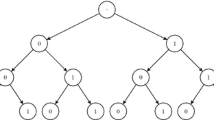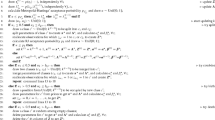Abstract
The assumptions underlying item response theory (IRT) models may be expressed as a set of equality and inequality constraints on the parameters of a latent class model. It is well known that the same assumptions imply that the parameters of the manifest distribution have to satisfy a more complicated set of inequality constraints which, however, are necessary but not sufficient. In this paper, we describe how the theory for likelihood-based inference under equality and inequality constraints may be used to test the underlying assumptions of IRT models. It turns out that the analysis based directly on the latent structure is simpler and more flexible. In particular, we indicate how several interesting extensions of the Rasch model may be obtained by partial relaxation of the basic constraints. An application to a data set provided by Educational Testing Service is used to illustrate the approach.
Similar content being viewed by others
References
Agresti A. (1994) Simple capture-recapture models permitting unequal catchability and variable sampling effort. Biometrics, 50:494–500
Aitchison J., Silvey S.D. (1958) Maximum likelihood estimation of parameters subject to restraints. Annals of Mathematical Statistics, 29:813–828
Bartolucci F., Forcina A. (2000) A likelihood ratio test for MTP2 within binary variables. The Annals of Statistics, 28:1206–1218
Bartolucci F., Forcina A. (2001) The analysis of capture-recapture data with a Rasch-type model allowing for conditional dependence and multidimensionality. Biometrics, 57:207–212
Bartolucci F., Forcina A., Dardanoni V. (2001) Positive quadrant dependence and marginal modelling in two-way tables with ordered marginals. Journal of the American Statistical Association, 96:1497–1505
Bergsma W.P. (1997) Marginal Models for Categorical Data. Tilburg: Tilburg University Press
Chernoff H. (1954) On the distribution of the likelihood ratio. Annals of Mathematical Statistics, 25:573–578
Colombi R., Forcina A. (2001) Marginal regression models for the analysis of positive association of ordinal response variables. Biometrika, 88:1007–1019
Croon M. (1990) Latent class analysis with ordered latent classes. British Journal of Mathematical and Statistical Psychology, 43:171-192
Dardanoni V., Forcina A. (1998) A unified approach to likelihood inference on stochastic orderings in a nonparametric context. Journal of the American Statistical Association, 93:1112–1123
Darroch J.N., Fienberg S.E., Glonek G.F.V., Junker B.W. (1993) A three-sample multiple-recapture approach to census population estimation with heterogeneous catchability. Journal of the American Statistical Association, 88:1137–1148
Glonek G.E.V. (1996) A Class of regression models for multivariate categorical responses. Biometrika, 83:15–28
Hambleton R.K., Swaminathan H. (1996) Item Response Theory: Principles and Applications. Boston: Kluwer Nijhoff Publishing.
Hemker B.T., Sijstma K., Molenaar I.W., Junker B.W. (1997) Stochastic ordering using the latent trait and the sum score in polytomous IRT models. Psychometrika, 62:331–347
Hoijtink H., Molenaar I.W. (1997) A multidimensional item response model: constrained latent class analysis using the Gibbs sampler and posterior predictive checks. Psychometrika, 62:171–189
Holland P.W., Rosenbaum P.R. (1986) Conditional association and unidimensionality in monotone latent variable models. The Annals of Statistics, 14:1523–1543
Ip E.H. (2001) Testing for local dependency in dichotomous and polytomous items response models. Psychometrika, 66:109–132
Ip E.H. (2002) Locally dependent latent trait model and the Dutch identity revised, Psychometrika, 67:367–386
Junker B.W., Ellis J.L. (1997) A characterization of monotone unidimensional latent variable models. The Annals of Statistics, 25:1327–1343
Lindsay B., Clogg C., Grego J. (1991) Semiparametric estimation in the Rasch model and related exponential response models, including a simple latent class model for item analysis. Journal of the American Statistical Association, 86:96–107
Madansky A. (1960) Determinal methods in latent class analysis. Psychometrika, 25:183–198
McLachlan G.J., Peel D. (2001) Finite Mixture Models. New York: Wiley
Rasch G. (1961) On general laws and the meaning of measurement in psychology. In Proceedings of the IV Berkeley Symposium on Mathematical Statistics and Probability, 4:321–333
Rosenbaum P.R. (1984) Testing the conditional independence and monotonicity assumption of item response theory. Psychometrika, 49:425–435
Settimi R., Smith J.W. (2000) Geometry, moments and conditional independence trees with hidden variables. The Annals of Statistics, 28:1179–1205
Shapiro A. (1985) Asymptotic distribution of test statistics in the analysis of moment structures under inequality constraints. Biometrika, 72:133–144
Shapiro A. (1988) Towards a unified theory of inequality constrained testing in multivariate analysis. International Statistical Review, 56:1137–1156
Sijstma K. (2001) Developments in measurement of persons and items by means of item response models. Behaviormetrika, 28:65–94
van der Heijden, P., Hart, t’H., Dessens, J. (1997). A parametric bootstrap procedure to perform statistical tests on a LCA of anti-social behaviour. In J. Rost, and R. Langeheine. (Eds.). Applications of Latent Trait and Latent Class Models in the Social Sciences. Berlin: Waxman Münster.
Vermunt J.K. (1999) A general class of non-parametric models for ordinal categorical data. Sociological Methodology, 29:187–224
Vermunt J.K. (2001) The use of restricted latent class model for defining and testing non parametric and parametric item response theory models. Applied sychological Measurement, 25:283–294
Vermunt J.K., Magidson J. (2003) Latent class analysis. In M. Lewis-Beck, A. Bryman, T.F. Liao (Eds). Encyclopedia of Research Methods for the Social Sciences. NewBury Park: Sage Publications.
Author information
Authors and Affiliations
Corresponding author
Additional information
We thank Dr. Gorman and Dr. Rogers of the Educational Testing Service for providing the data analyzed in Section 4. We also thank three reviewers for comments and suggestions.
Rights and permissions
About this article
Cite this article
Bartolucci, F., Forcina, A. Likelihood inference on the underlying structure of IRT models. Psychometrika 70, 31–43 (2005). https://doi.org/10.1007/s11336-001-0934-z
Published:
Issue Date:
DOI: https://doi.org/10.1007/s11336-001-0934-z




